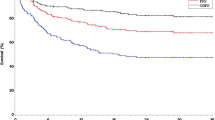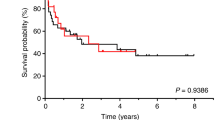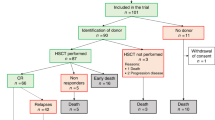Abstract
Relapsed or refractory Hodgkin lymphoma (advanced HL) still remains a therapeutic challenge. Recently, unmanipulated haploidentical related donor transplant with reduced conditioning regimen (HAPLO-RIC) and post-transplant cyclophosphamide (PT-Cy) as GvHD prophylaxis has became a promising rescue strategy potentially available to almost every patient. This paper reports our multicenter experience using an IV busulfan-based HAPLO-RIC regimen and PT-Cy in the treatment of 43 patients with advanced HL. Engraftment occurred in 42 patients (97.5%), with a median time to neutrophil and platelet recovery of 18 and 26 days. Cumulative incidences of grades II–IV acute GvHD and chronic GvHD were 39% and 19%, respectively. With a median follow-up of 25.5 months for survivors, 27 patients are alive, with 22 of them disease free. Cumulative incidences of 1-year non-relapse mortality and relapse at 2 years were 21% and 24%, respectively. The estimated 2-year event-free survival (EFS) and overall survival (OS) were 48% and 58%, respectively. CR prior to HAPLO-RIC correlated with better EFS (78.5% vs 33.5%; P=0.015) and OS (86% vs 46%; P=0.044). Our findings further confirm prior reports using HAPLO-RIC in advanced HL in a multicenter approach employing an IV busulfan-based conditioning regimen.
This is a preview of subscription content, access via your institution
Access options
Subscribe to this journal
Receive 12 print issues and online access
$259.00 per year
only $21.58 per issue
Buy this article
- Purchase on Springer Link
- Instant access to full article PDF
Prices may be subject to local taxes which are calculated during checkout






Similar content being viewed by others
References
Follows GA, Ardeshna KM, Barrington SF, Culligan DJ, Hoskin PJ, Linch D et al. Guidelines for the first line management of classical Hodgkin lymphoma. Br J Haematol 2014; 166: 34–49.
Kharfan-Dabaja MA, Hamadani M, Sibai H, Savani BN . Managing Hodgkin lymphoma relapsing after autologous hematopoietic cell transplantation: a not-so-good cancer after all!. Bone Marrow Transplant 2014; 49: 599–606.
Sureda A, Domenech E, Schmitz N, Dreger P . Lymphoma Working Party of the European Group for Stem Cell Transplantation. The role of allogeneic stem cell transplantation in Hodgkin's lymphoma. Curr Treat Options Oncol 2014; 15: 238–247.
Alvarez I, Sureda A, Caballero MD, Urbano-Ispizua A, Ribera JM, Canales M et al. Nonmyeloablative stem cell transplantation is an effective therapy for refractory or relapsed hodgkin lymphoma: results of a Spanish prospective cooperative protocol. Biol Blood Marrow Transplant 2006; 12: 172–183.
Sarina B, Castagna L, Farina L, Patriarca F, Benedetti F, Carella AM et al. Allogeneic transplantation improves the overall and progression-free survival of Hodgkin lymphoma patients relapsing after autologous transplantation: a retrospective study based on the time of HLA typing and donor availability. Blood 2010; 115: 3671–3677.
Sureda A, Robinson S, Canals C, Carella AM, Boogaerts MA, Caballero D et al. Reduced-intensity conditioning compared with conventional allogeneic stem-cell transplantation in relapsed or refractory Hodgkin’s lymphoma: an analysis from the Lymphoma Working Party of the European Group for Blood and Marrow Transplantation. J Clin Oncol 2008; 26: 455–462.
Robinson SP, Sureda A, Canals C, Russell N, Caballero D, Bacigalupo A et al. Reduced intensity conditioning allogeneic stem cell transplantation for Hodgkin's lymphoma: identification of prognostic factors predicting outcome. Haematologica 2009; 94: 230–238.
Sureda A, Canals C, Arranz R, Caballero D, Ribera JM, Brune M et al. Allogeneic stem cell transplantation after reduced intensity conditioning in patients with relapsed or refractory Hodgkin’s lymphoma. Results of the HDR-ALLO study - a prospective clinical trial by the Grupo Español de Linfomas/Trasplante de Médula Osea (GEL/TAMO) and the Lymphoma Working Party of the European Group for Blood and Marrow Transplantation. Haematologica 2012; 97: 310–317.
Peggs KS, Hunter A, Chopra R, Parker A, Mahendra P, Milligan D et al. Clinical evidence of a graft-versus-Hodgkin's-lymphoma effect after reduced-intensity allogeneic transplantation. Lancet 2005; 365: 1934–1941.
Burroughs LM, O'Donnell PV, Sandmaier BM, Storer BE, Luznik L, Symons HJ et al. Comparison of outcomes of HLA-matched related, unrelated, or HLA-haploidentical related hematopoietic cell transplantation following nonmyeloablative conditioning for relapsed or refractory Hodgkin lymphoma. Biol Blood Marrow Transplant 2008; 14: 1279–1287.
Raiola A, Dominietto A, Varaldo R, Ghiso A, Galaverna F, Bramanti S et al. Unmanipulated haploidentical BMT following non-myeloablative conditioning and post-transplantation CY for advanced Hodgkin's lymphoma. Bone Marrow Transplant 2014; 49: 190–194.
Castagna L, Bramanti S, Furst S, Giordano L, Crocchiolo R, Sarina B et al. Nonmyeloablative conditioning, unmanipulated haploidentical SCT and post-infusion CY for advanced lymphomas. Bone Marrow Transplant 2014; 49: 1475–1480.
Luznik L, O'Donnell PV, Symons HJ, Chen AR, Leffell MS, Zahurak M et al. HLA-haploidentical bone marrow transplantation for hematologic malignancies using nonmyeloablative conditioning and high-dose, posttransplantation cyclophosphamide. Biol Blood Marrow Transplant 2008; 14: 641–650.
Armand P, Kim HT, Logan BR, Wang Z, Alyea EP, Kalaycio ME et al. Validation and refinement of the Disease Risk Index for allogeneic stem cell transplantation. Blood 2014; 123: 3664–3671.
Przepiorka D, Weisdorf D, Martin P, Klingemann HG, Beatty P, Hows J et al. Meeting report. Consensus conference on acute GVHD grading. Bone Marrow Transplant 1995; 15: 825–828.
Shulman HM, Sullivan KM, Weiden PL, McDonald GB, Striker GE, Sale GE et al. Chronic graft-versus-host syndrome in man. A long-term clinicopathologic study of 20 Seattle patients. Am J Med 1980; 69: 204–217.
Buño I, Nava P, Simón A, González-Rivera M, Jiménez JL, Balsalobre P et al. A comparison of fluorescent in situ hybridization and multiplex short tandem repeat polymerase chain reaction for quantifying chimerism after stem cell transplantation. Haematologica 2005; 90: 1373–1379.
Gooley TA, Leisenring W, Crowley J, Storer BE . Estimation of failure probabilities in the presence of competing risks: new representations of old estimators. Stat Med 1999; 18: 695–706.
Gayoso J, Balsalobre P, Pascual MJ, Castilla-Llorente C, Kwon M, Serrano D et al. Busulfan based reduced intensity conditioning regimen for haploidentical transplantation in relapsed/refractory Hodgkin lymphoma: Spanish multicenter experience. Bone Marrow Transplant 2015; 50: S6 (O-008).
Santos GW, Tutschka PJ, Brookmeyer R, Saral R, Beschorner WE, Bias WB et al. Marrow transplantation for acute nonlymphocytic leukemia after treatment with busulfan and cyclophosphamide. N Engl J Med 1983; 309: 1347–1353.
Santos GW . Busulfan (Bu) and cyclophosphamide (Cy) for marrow transplantation. Bone Marrow Transplant 1989; 4: 236–239.
Raj K, Pagliuca A, Bradstock K, Noriega V, Potter V, Streetly M et al. Peripheral blood hematopoietic stem cells for transplantation of hematological diseases from related, haploidentical donors after reduced-intensity conditioning. Biol Blood Marrow Transplant 2014; 20: 890–895.
Castagna L, Crocchiolo R, Furst S, Bramanti S, El Cheikh J, Sarina B et al. Bone marrow compared with peripheral blood stem cells for haploidentical transplantation with a nonmyeloablative conditioning regimen and post-transplantation cyclophosphamide. Biol Blood Marrow Transplant 2014; 20: 724–729.
McCurdy SR, Kanakry JA, Showel MM, Tsai HL, Bolaños-Meade J, Rosner GL et al. Risk-stratified outcomes of nonmyeloablative HLA-haploidentical BMT with high-dose posttransplantation cyclophosphamide. Blood 2015; 125: 3024–3031.
Zeidan AM, Forde PM, Symons H, Chen A, Smith BD, Pratz K et al. HLA-haploidentical donor lymphocyte infusions for patients with relapsed hematologic malignancies after related HLA-haploidentical bone marrow transplantation. Biol Blood Marrow Transplant 2014; 20: 314–318.
Ghiso A, Raiola AM, Gualandi F, Dominietto A, Varaldo R, Van Lint MT et al. DLI after BMT with post-transplant DLI. Bone Marrow Transplant 2015; 50: 56–61.
Acknowledgements
This work was partially supported by the Ministry of Economy and Competitiveness ISCIII-FIS grants PI11/00708, PI14/01731 and RD12/0036/0061, co-financed by ERDF (FEDER) Funds from the European Commission, ‘A way of making Europe’, as well as grants from Asociación Española Contra el Cáncer (AECC) and Fundación Mutua Madrileña (FMM).
Author information
Authors and Affiliations
Consortia
Corresponding author
Ethics declarations
Competing interests
The authors declare no conflict of interest.
Rights and permissions
About this article
Cite this article
Gayoso, J., Balsalobre, P., Pascual, M. et al. Busulfan-based reduced intensity conditioning regimens for haploidentical transplantation in relapsed/refractory Hodgkin lymphoma: Spanish multicenter experience. Bone Marrow Transplant 51, 1307–1312 (2016). https://doi.org/10.1038/bmt.2016.115
Received:
Revised:
Accepted:
Published:
Issue Date:
DOI: https://doi.org/10.1038/bmt.2016.115
This article is cited by
-
Haploidentical stem cell transplantation for patients with lymphoma: a position statement from the Lymphoma Working Party-European Society for Blood and Marrow Transplantation
Bone Marrow Transplantation (2020)
-
Outcome after autologous stem cell transplantation in primary refractory or relapsed Hodgkin lymphoma—a long-term follow-up single center experience
Annals of Hematology (2020)
-
Haploidentical related donor compared to HLA-identical donor transplantation for chemosensitive Hodgkin lymphoma patients
BMC Cancer (2020)
-
Prevention and treatment of relapse after stem cell transplantation in lymphoid malignancies
Bone Marrow Transplantation (2019)
-
Retrospective study of the digestive tract mucositis derived from myeloablative and non-myeloablative/reduced-intensity conditionings with busulfan in hematopoietic cell transplantation patient
Supportive Care in Cancer (2019)



